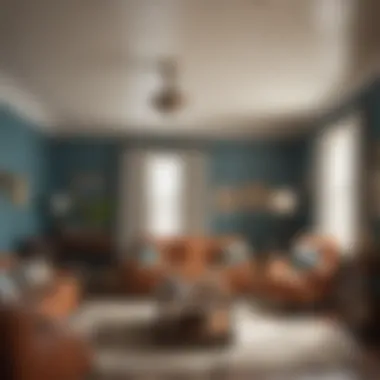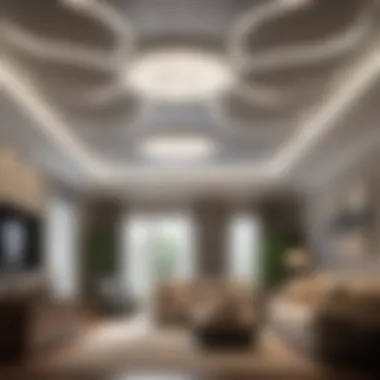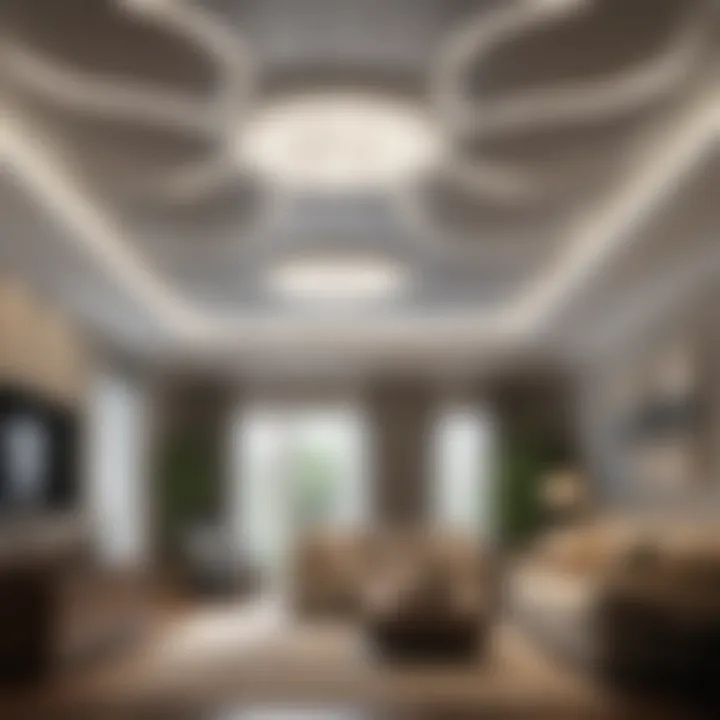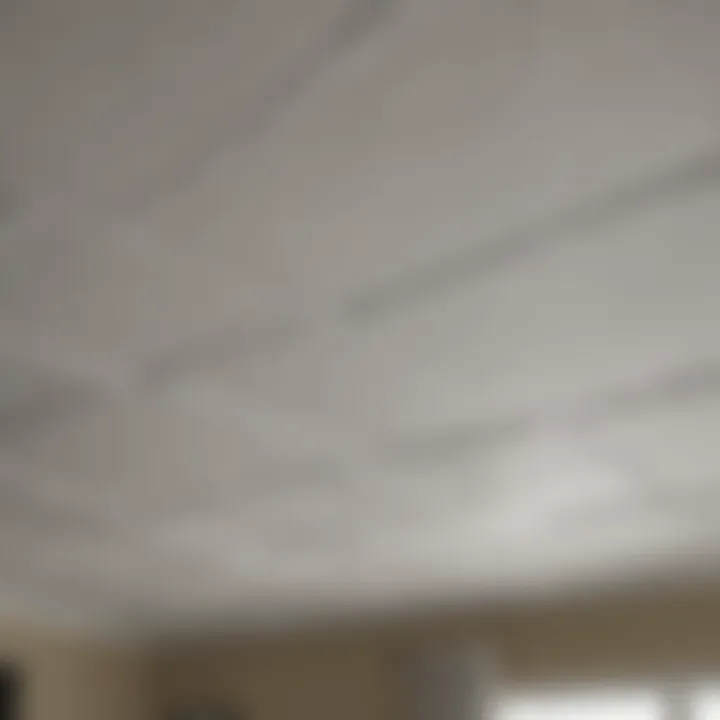Exploring the Popcorn Ceiling Phenomenon: History and Trends


Intro
Peering into the history of interior design, you'd likely stumble upon a curious case: the popcorn ceiling. Once a household name in home decor, this textured ceiling style emerged as a true hallmark of mid-century architecture. Yet, as fashions shifted and preferences evolved, popcorn ceilings fell out of favor, becoming almost synonymous with outdated aesthetics. This article seeks to traverse the journey of popcorn ceilings—from their heyday as a decorating trend to their decline and the ongoing debates over their removal. With many homeowners wrestling with whether to keep or ditch their ceilings, this exploration provides a nuanced understanding of the implications involved.
Key Insights and Trends
Current Trends in Interior Design
The realm of interior design is perpetually in motion, with trends cycling through myriad styles and concepts. In recent years, there’s been a clear shift toward clean lines, minimalist aesthetics, and an overall more contemporary vibe in homes. The popularity of open floor plans and natural light has rendered textures, particularly ones as bold as popcorn ceilings, less appealing. Instead, homeowners are opting for smooth finishes, such as satin or matte ceilings, which can suit a variety of design themes while enhancing the overall lightness of a room.
Another rising trend is the embrace of biophilic design, which emphasizes the integration of nature within indoor spaces. This trend often encourages using eco-friendly materials and techniques that align more closely with nature's aesthetic, offering softer, more organic-looking surfaces that steer away from heavy textures.
Alternatives to Popcorn Ceilings
As the preference for smoother ceilings has grown, manufacturers now offer a plethora of options for homeowners looking to replace their popcorn texture. For instance, materials such as shiplap or tongue-and-groove boards can add a rustic charm while providing a clean finish. Additionally, engineered wood ceilings or plaster alternatives have gained traction, aligning with current design ethos emphasizing quality and sustainability.
When choosing an alternative, factors such as durability, maintenance, and cost should all come into consideration. Fortunately, many contemporary options often require less upkeep compared to their textured predecessors.
"As styles evolve, understanding the nuances of what’s on your ceiling is as important as what’s on your walls."
Practical Tips and How-To Guides
For homeowners contemplating their next steps concerning popcorn ceilings, having a structured approach can prove invaluable. Here, some practical guidance can help you with the process, whether you decide to restore or replace this unique element of home decor.
Step-by-Step Guide for Removal
- Safety First: If your ceiling was installed prior to 1978, consider having it tested for asbestos. If present, professional removal is crucial.
- Gather Your Supplies: You’ll need a spray bottle, water, a large scraper, ladder, and drop cloths.
- Wet the Ceiling: Lightly spray the ceiling with water, allowing it to soak for about 15 minutes. This prepares the texture for scraping.
- Scrape Away: Use a wide scraper to gently remove the popcorn texture, working from one corner of the room to the next.
- Clean Up: Go over the area with a sponge and clean water to wipe away any residue, followed by a thorough clean of the space.
Consideration for Restoration
If the textured ceiling is in decent shape, you might choose to simply freshen it up. A coat of paint can breathe new life into the ceiling without the fuss of removal. Opt for a fresh white or a soft off-white paint to enhance the room's brightness.
In summation, whether you decide to embrace the popcorn ceiling for its nostalgic charm or wave goodbye to it in favor of a more modern look, understanding its background and the current trends can significantly inform your choices. As interior design continues to evolve, so too does the conversation surrounding what lies overhead.
Historical Context of Popcorn Ceilings
Understanding popcorn ceilings begins with a look back at their genesis. This style emerged prominently in the mid-20th century, notably during a period when homeowners sought innovative ways to finish their ceilings. Popcorn ceilings were not just a decorative choice; they catered to practical needs of the time, such as affordability and ease of maintenance. This narrative sheds light on the societal shifts influencing home design, expanding the discussion beyond aesthetics to include economic and cultural considerations, making it a topic of interest for both homeowners and interior design enthusiasts.
Origin and Popularization
Popcorn ceilings, also referred to as textured ceilings or acoustic ceilings, became fashionable in the late 1950s and continued to capture the imagination of homeowners into the 1980s. The driving force behind their popularity was multifaceted. Homeowners embraced this trend largely due to the rapid expansion of suburbs, financial accessibility, and a taste for unique yet simple home designs.
Initially, the texture was achieved through a spray-on application, which made it much easier to cover up blemishes and imperfections commonly found in drywall. Adding to this was the allure of acoustic properties. The texture helped to absorb sound, making it a practical choice for noisy environments. For many families during that booming era, the home was a sanctuary, and anything that helped create a serene and homey atmosphere was welcome.
These ceilings could also mask the touch of a novice during a home renovation. A lack of skilled labor was another factor that spurred the popularity. This allowed homeowners to feel empowered in their DIY projects without worrying excessively about perfectly flat ceiling finishes. In essence, this ceiling style reflected a mindset geared towards practicality and affordability—a hallmark of post-war American ideals.
Decline in Popularity
However, the pendulum of design always swings. As we moved into the 1990s, preferences began to shift towards a more modern and sleek aesthetic. Homeowners started to favor smooth or minimally textured ceilings, driven partly by preferences influenced by design trends in media and a greater focus on clean lines in architecture.
Health and environmental factors became increasingly relevant as awareness of materials used in these ceilings emerged. Many popcorn ceilings contained asbestos, a now-known carcinogen, raising eyebrows and prompting homeowners to reconsider their previous choices. Moreover, the difficulty of maintenance with these textured surfaces became apparent; a simple clean could quickly transform into a laborious endeavor filled with fluff and dust. Homeowners found the idea of scraping off the popcorn texture more appealing than keeping it intact.
As property value assessments evolved, smooth ceilings began to symbolize a more desirable aesthetic in real estate. In conversations about home values, *
Structural and Practical Aspects
When considering popcorn ceilings, one must delve into the structural and practical aspects that these textured ceilings offer. Often, homeowners may undervalue how these features not only contribute to the aesthetics of a room but also serve specific functions that can enhance the living experience. Just like many design choices in a home, it's crucial to understand the full implications of keeping or removing this textured surface.
Noise Reduction Properties


One remarkable aspect of popcorn ceilings is their ability to effectively dampen sound. This characteristic is particularly prominent in spaces where noise reduction is a priority, such as homes with children, multi-room apartments, or any setup where quiet is a luxury. The texture of the popcorn finish creates an irregular surface that helps to break up and absorb sound waves, thereby reducing echo and minimizing noise transmission.
For instance, imagine a lively family dinner where laughter fills the air but you still want some semblance of peace in a nearby room. The popcorn ceiling acts as a buffer, ensuring that sounds don’t travel far and wide, making your home feel more serene. Many homeowners might not realize that simply retaining this ceiling texture can lead to a more tranquil environment.
However, it's worth noting that not all textures are created equal; some may provide better acoustic benefits than others. It’s advisable to assess the quality of the finish when making decisions.
Concealment of Imperfections
Another practical element of popcorn ceilings lies in their ability to hide imperfections. In many older homes, there's a likelihood of uneven drywall surfaces, cracks, or other blemishes. Popcorn ceilings serve a functional purpose by obscuring these flaws, lending an appearance of uniformity that new homeowners might find particularly appealing.
This can be especially vital when cost is a concern. Repairing ceiling imperfections can be a daunting task, often involving significant time and resources. Instead, a popcorn finish can cleverly mask these issues, allowing homeowners to manage their budget without sacrificing visual appeal.
On a similar note, consideration should be given to the long-term impact of keeping it. If damages occur over time that warrant more than just surface-level repair, removing the popcorn texture to address underlying problems may become necessary.
As you ponder whether to embrace or reject this textured ceiling solution, remember that each home is unique. From the humming of everyday life to the aesthetics in play, the decision to keep or replace popcorn ceilings involves more than just trend—it's about embracing the character of your space.
Aesthetic Choices Behind Popcorn Ceilings
The aesthetic choices related to popcorn ceilings are not just about what meets the eye at a glance. They reflect broader design trends of their time, as well as homeowner preferences and practical considerations. Understanding these elements provides insights into why these ceilings became ubiquitous in many homes and why they remain a topic despite their decline.
Design Trends of the Past
Popcorn ceilings gained popularity in the mid-20th century, a time when the ethos of design was shifting toward affordability and simplicity. With the post-war housing boom, builders were eager to fulfill the needs of a growing population. Homeowners sought low-maintenance, stylish options, and popcorn ceilings fit the bill perfectly.
These ceilings, officially known as acoustic ceilings or stucco ceilings, were touted for their unique appearance. They offered a textured finish that masked imperfections in ceilings. The visual texture often appealed to homeowners who wanted something beyond plain drywall but were not ready to commit to more intricate designs like coffered or tray ceilings.
Furthermore, the muted surfaces worked well with the popular wall colors of past decades—think avocado green and burnt orange, which often complemented the retro aesthetic. Homeowners enjoyed the idea of a ceiling that could blend in with their overall decor—functional yet stylistic.
Textural Variations and Visual Impact
Moving into the 1980s and ‘90s, popcorn ceilings still held their ground as preferences turned towards bolder design choices, but many found the surface a bit limiting. Over time, textural variations emerged that allowed for different levels of depth and dimension. Some opted for lighter, fluffier textures, while others went for a more coarse finish that resembled stucco. Each type brought its own unique touch to a living space.
From a visual perspective, these textures could create an illusion of height and space. The mottled patterns catch light in various ways, creating shadows that help soften a room's atmosphere. That's why they were particularly favored in smaller areas where high ceilings were not an option. The curvy and irregular surfaces could visually compensate, giving a feeling of expanded volume.
When looking at modern trends, however, the same visual impact is more frequently achieved with smoother finishes or complex designs using paint or wallpaper. It’s a testament to changing tastes—some people now seek clean lines that speak of minimalism, steering clear of the texture that once defined their living environments.
"Design is about more than just appearance. It’s about how a space feels and functions. The evolution of ceiling choices reflects broader cultural shifts and individual preferences."
Surprisingly, not all homes opt for uniformity. The textures from popcorn ceilings can create personality in individual spaces. For those looking to maintain their popcorn ceilings, painting can yield a fresh look—akin to breathing new life into art by altering its frame.
In summary, the aesthetic choices behind popcorn ceilings illustrate a balancing act between function and style. These ceilings served a purpose beyond mere appearance, addressing practical concerns while contributing to the overall character of homes during their heyday.
Health and Safety Considerations
In the discussion surrounding popcorn ceilings, the topic of health and safety cannot be overstated. Many homeowners might overlook this aspect, often prioritizing aesthetic or cost factors. However, understanding the associated health risks and necessary maintenance is crucial when dealing with these textured ceilings. Two significant aspects that warrant particular attention are asbestos concerns and the maintenance and cleaning challenges that come with popcorn ceilings.
Asbestos Concerns
For decades, popcorn ceilings were lauded for their ability to conceal imperfections, providing a quick fix for many homeowners. However, the introduction of asbestos into the popcorn material for spray-on ceilings raised pivotal alarm. Asbestos fibers, once considered a miracle material for insulation and fireproofing, are now known as a serious health hazard.
If your house was built before the 1980s, it’s prudent to assume that your popcorn ceiling might contain asbestos. The dust produced when these ceilings are disturbed can lead to serious lung conditions, including asbestosis and even mesothelioma, a particularly aggressive form of cancer.
Here are key safety considerations regarding asbestos:
- Testing: If the popcorn ceiling is suspected to contain asbestos, a professional assessment is crucial. Homeowners should seek accredited inspectors to carry out this analysis safely.
- Avoid DIY Removal: Disturbing a popcorn ceiling can release harmful fibers into the air. Homeowners should never attempt to remove or repair the ceiling without taking appropriate precautions.
- Encapsulation vs. Removal: Depending on the condition of the ceiling, it may be safer to encapsulate it rather than removing it entirely. Professional contractors can apply a sealant to prevent asbestos fibers from becoming airborne.
It's better to be safe than sorry. Always consult professionals when dealing with potential asbestos risks. Safety first!
Maintenance and Cleaning Challenges
Maintaining a popcorn ceiling can be likened to keeping an unruly garden. While the textured surface provides a certain charm, it also poses unique cleaning challenges. Accumulated dust and debris can easily settle into the peaks and valleys of the texture, making it difficult to keep clean.


Some of the common issues associated with maintenance include:
- Dust Accumulation: Regular dusting is essential, but popcorn ceilings require a bit more finesse. A simple wipe down may not suffice. Homeowners should use a vacuum with a brush attachment or a duster to gently remove dust without damaging the surface.
- Stains and Water Marks: If a leak occurs, stains can mar the ceiling's appearance. Cleaning these stains can be a tricky endeavor. It’s best to consult with professionals or use specialized products designed for textured ceilings.
- Invasion of Pests: Textured surfaces can be inviting for pests such as spiders and cobwebs. These maintenance issues require vigilant home care to avoid unwanted surprises hanging from the ceiling.
Taking care of popcorn ceilings involves not just aesthetic upkeep but also health consideration. Homeowners should be informed and cautious, ensuring that any measures they take align with best safety practices. By focusing on these health implications, individuals can make more informed decisions about their ceiling choices.
Modern Alternatives to Popcorn Ceilings
The dialogue around popcorn ceilings has shifted in recent years, leading homeowners and design enthusiasts to explore more modern alternatives. Understanding these choices is essential for anyone looking to rejuvenate their living spaces. Shifting away from the nostalgic textures of the past opens up a realm of possibilities that can reflect personal style while enhancing property value. So, let’s roll up our sleeves and see what’s cooking in the world of ceiling design today.
Smooth Ceilings
Smooth ceilings are the epitome of contemporary elegance. These plain, untextured finishes create an illusion of height, making rooms appear spacious and airy. Particularly in small spaces, this effect is not just beneficial but essential. Homeowners also cherish the ease of maintenance that comes with this clean finish. Dust and dirt accumulate less on smooth surfaces, leading to many opting for them when considering longevity in their aesthetic.
The aesthetic versatility of smooth ceilings allows them to serve as a blank canvas, adapting to different decor styles, from minimalist to traditional. Unlike popcorn ceilings, which can confine other design elements, smooth ceilings harmonize seamlessly, whether paired with bold statement lighting or intricate crown molding.
Moreover, transitioning to a smooth ceiling can dramatically enhance the resale value of your home. When prospective buyers see an updated, modern ceiling, it lends a fresh feel that can sway purchase decisions. A few coats of paint can do wonders to further breathe life into these surfaces, allowing for easy personalization.
Textured Options
Texture is a powerful design tool that can provide depth and interest to a ceiling. While popcorn ceilings might have dominated the tactile landscape of the past, modern textured options have emerged that resonate more with today’s aesthetic sensibilities. From subtle to striking, the variety here caters to diverse tastes and preferences.
- Knockdown texture is one popular choice that creates a rugged look without being overly bold. It involves applying a joint compound to the ceiling and then knocking it down with a trowel, resulting in a surface that’s both modern and inviting.
- Stippled patterns can add a hint of whimsy that might suit more casual or eclectic spaces, especially where family gatherings and creativity take center stage.
What's more, such textures are not merely decorative; they can also help with acoustics, reducing noise levels in open-concept living areas. Choosing the right texture can turn an ordinary ceiling into an element of architectural interest.
As homeowners prioritize personalization and uniqueness in their spaces, it's clear that these modern alternatives fill a void once filled by the cottage industry of popcorn ceilings. Each option opens doors to creativity without the baggage of outdated perceptions.
"Adapting to modern tastes, the choice of ceiling finish can drastically shift not just the aesthetic but also the energy of a room. It's where form meets function."
Financial Implications of Ceiling Choices
When considering home renovations, the financial implications of ceiling choices can be quite significant. This section examines the costs associated with popcorn ceilings, both in terms of removal and retention, and how these decisions can influence the overall value of a property. Understanding these elements can guide homeowners in making informed choices that align with their budgets and aesthetic preferences.
Cost of Removal vs. Retention
Deciding whether to remove or retain popcorn ceilings often boils down to the expenses involved. Removal costs can vary widely, depending on the size of the area and the condition of the ceiling. Homeowners can expect to spend anywhere from $1 to $3 per square foot for professional removal, which includes labor and disposal fees. For a standard room of about 300 square feet, this can quickly add up, potentially hitting between $300 to $900.
On the other hand, retaining the popcorn ceiling may seem cost-effective in the short term. However, the potential drawbacks could turn out to be more costly. Aside from the initial outlay for installation and finishing, maintaining the texture can bring hidden expenses. For instance, cleaning and painting can be tricky; the textured surface is more prone to trapping dirt and stains, resulting in increased costs over time for upkeep.
"While removal may feel like a big bite out of the budget, in the long run, it can often lead to greater financial savings and aesthetic appeal."
For those who opt for DIY removal, the costs can be lower, but it requires an investment of time and effort. Also, there may be hidden dangers like asbestos, particularly in homes built before 1980, which can significantly escalate removal costs if professionals need to handle the hazardous materials.
Value Impact on Property Sales
The value impact on property sales is another critical consideration. In many markets, homes with popcorn ceilings struggle to compete against those with modern finishes. While a popcorn ceiling can evoke a certain vintage charm, many buyers may perceive it as outdated or indicative of insufficient maintenance. This can lead to lower offers or prolonged time on the market.
In areas where there is a high demand for contemporary aesthetics, removing popcorn ceilings can provide a better return on investment. A freshly finished ceiling can enhance the home’s appeal, potentially increasing its value by several thousand dollars.
Factors to consider include:
- Market Trends: In regions where minimalist design prevails, modern ceiling styles are more desirable.
- Buyer's Perspective: Many potential buyers have a strong aversion to popcorn ceilings, influencing their willingness to buy and at what price.
- Home Inspection Outcomes: Homes with popcorn texture may receive lower marks during inspections, affecting the final selling price.
Ultimately, savvy homeowners must weigh the initial costs against long-term benefits. Making well-informed decisions about ceiling choices can play a pivotal role in both enjoying the living space and securing a favorable sale down the line.
DIY vs. Professional Installation
In the realm of popcorn ceilings, the choice between tackling the task yourself or opting for professional help is significant. Homeowners often find themselves standing at this crossroad, grappling with a myriad of considerations that shape their decisions. While the DIY route can feel liberating, allowing creativity and personal input, engaging a professional often guarantees a level of expertise that can be challenging to replicate.


Advantages of DIY Projects
Engaging in a DIY project can be both fulfilling and economical. By rolling up your sleeves and diving into your interior upgrade, you can save a notable sum since labor costs can add up quickly in a professional setting.
- Cost Savings: You sidestep labor fees, which can make a significant dent in your overall budget. Instead of spending hundreds or even thousands, your financial commitment is primarily for materials.
- Personal Satisfaction: There’s a certain pride that comes from creating something yourself. Seeing the results of your effort can bring a sense of accomplishment that’s hard to beat.
- Customization: With DIY, you’re in the driver seat. You can explore various techniques or textures and tailor the outcome to precisely match your vision for the space. Choices abound from modern smooth finishes to more playful textures that can jazz up a room.
- Learning Experience: You might just discover new skills along the way. Whether it’s learning how to mix and match materials or mastering a new painting technique, the process can be both educational and empowering.
However, it’s worth noting that the DIY path isn’t for everyone. It takes time, effort, and a willingness to potentially navigate unexpected hurdles along the way.
When to Hire a Professional
While the DIY approach can be attractive, sometimes it’s prudent to ring up an expert. Depending on your unique situation, a professional can offer invaluable benefits that shouldn’t be overlooked.
- Expertise and Experience: Professionals bring years of training and experience. Their knowledge can help avoid common pitfalls that novices might encounter. Not only can they provide high-quality results, but their assurance often comes with warranties.
- Safety Concerns: If your ceiling contains asbestos or presents any health hazards, professional removal is essential. Asbestos handling requires certification and safety protocols, making it imperative to recruit someone that is trained to deal with hazardous materials.
- Time Constraints: Let’s face it, time often escapes us. If you find yourself with a busy schedule, hiring someone might be a smarter move. Professionals can often complete the job in a fraction of the time it would take you.
- Specialized Tools: Certain jobs might need specialized equipment. Renting or purchasing these tools can drive up costs, so it may make more sense for a professional, who already has the required gear, to take on the job.
Overall, the decision often hinges on personal expertise, the complexity of the task, and the specific needs of your home. Ultimately, whichever route you choose, it’s critical to weigh these factors carefully to secure an outcome that aligns with your vision.
Cultural Perceptions and Trends
The realm of cultural perceptions and trends surrounding popcorn ceilings reflects the ever-changing tastes and values of society. At one time, these ceilings were a symbol of modern affordability, embraced in homes across the country. Now, shifting preferences and a growing awareness of design aesthetics have led many to reconsider their stance on this particular texture. Understanding these perceptions provides insights into broader architectural trends and homeowner motivations.
Regional Variations in Preference
Regional differences can play a defining role in how popcorn ceilings are viewed. In some areas, particularly where homes were built during the mid-20th century boom, popcorn ceilings may still hold nostalgic value and be considered charming. In contrast, urban centers and affluent neighborhoods tend to lean towards more modern, sleek designs. For example, homes in Los Angeles may favor smooth ceilings that reflect an airy, minimalistic chic, while some parts of the Midwest may still embrace that vintage aesthetic.
"Design is influenced not just by styles but also by the culture and environment surrounding it."
Cultural trends also shape perceptions. For instance, in the age of home-renovation TV shows, where the mantra often is "out with the old, in with the new," homeowners may feel pressured to follow suit. This brings about a collective push against popcorn ceilings as they seek to modernize their living spaces. Furthermore, online platforms like Reddit and Facebook showcase these changing views, with discussions often highlighting both the pros and cons of retaining such ceilings.
Influence of Media and Celebrity Trends
The sway of media and celebrity culture on interior design choices cannot be overlooked. Often, when a well-known figure showcases their elegant home devoid of textures like popcorn ceilings, it sends waves throughout the industry. Homeowners aspire to emulate these styles, believing that doing so elevates their own spaces. Social media platforms like Instagram and Pinterest amplify this effect, making minimalist aesthetics more attractive.
Moreover, the concept of authenticity and individuality plays into this too. As homeowners become more discerning and particular about their living spaces, they want their homes to reflect their unique tastes. The rise of influencers who promote curated and meticulously designed spaces often labels popcorn ceilings as outdated, reinforcing the idea that only the most modern options are worthy of attention.
Comprehending these cultural perceptions adds layers to the conversation about popcorn ceilings. It’s not just about materials and textures; it’s about the emotions and identities they convey within each dwelling. As homeowners navigate the journey of renovation or new construction, cultural trends and shifts in perception will invariably shape their decisions.
Future of Ceiling Design
The future of ceiling design is an intriguing topic, especially as modern homeowners and interior design enthusiasts seek to create spaces that are not only functional but also aesthetically pleasing. As tastes evolve, the shift away from traditional surfaces like popcorn ceilings becomes apparent. Instead, the focus has turned towards more innovative textures and materials that can enhance the overall atmosphere of a room. Understanding these changes isn't just about keeping up with trends; it's about recognizing the significant impact that design choices can have on living spaces.
Innovations in Texture and Materials
Recent innovation in ceiling designs has revived a sense of creativity that was, perhaps, muted in the days of popcorn. Homeowners now have a wide range of choices ranging from smooth finishes to intricate geometric patterns that play with light and shadow. New textures such as metallic, wood, or 3D panels not only bring character but also stimulate visual interest. For instance, shiplap, which has roots in nautical construction, is making its mark indoors, adding a rustic yet modern touch.
There's also the rise of acoustic panels, which not only serve as sound-dampening elements but are also stylish. Ensuring a cozy home while keeping it chic is a delicate balance—one that innovative designers are eagerly addressing.
Furthermore, manufacturers are getting creative with materials. The use of sustainable options like bamboo or recycled wood contributes not only to a room’s charm but also to eco-friendly living. As homeowners become more conscious about their environmental footprint, it's no surprise that they gravitate toward these options.
- Key textures gaining popularity:
- Metallic finishes
- Wood panels
- 3D textured panels
- Acoustic solutions
The development of materials that blend style with functionality indicates a promising path forward.
Sustainable Practices in Ceiling Finishing
In addition to innovative materials, there is a marked shift towards sustainability in the realm of ceiling finishing. As consumers become more aware of their environmental impact, they seek out methods and materials that align with eco-conscious choices. Sustainability in ceiling design goes beyond material selection; it also involves the application processes and the lifecycle of the products used.
For example, the adoption of low-VOC (Volatile Organic Compounds) paints not only minimizes harmful emissions but also gets the green stamp of approval from eco-enthusiasts. This practice reflects a broader commitment to health — and not just in aesthetic terms but physical health as well.
In terms of installation, rethinking existing materials can yield significant benefits. Homeowners opting for ceiling overlays or restoration techniques rather than complete replacements can preserve their original architecture while reducing waste. Plus, these practices can be financially beneficial, saving dollars that would otherwise go towards extensive renovations.
- Sustainable practices to consider:
- Using low-VOC paints
- Incorporating recycled and natural materials
- Exploring restoration techniques over replacements
In summary, the future of ceiling design is not just about what is trending; it's about creating a harmonious balance of style and sustainability. Emphasizing innovative textures and eco-friendly practices, new ceiling designs cater to the desires of a populace eager for change—while also conserving the environment.



